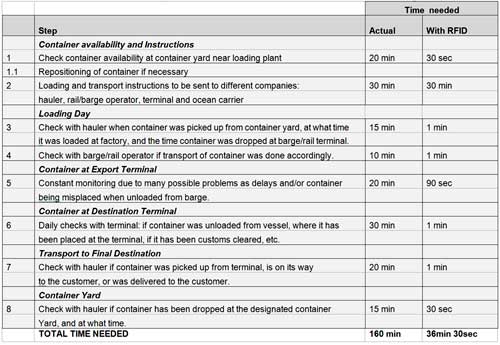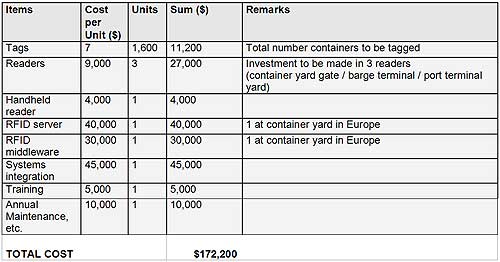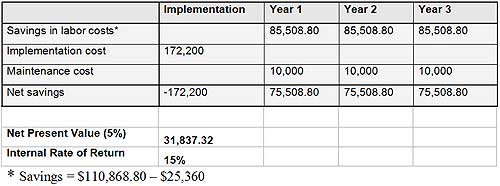The decision to deploy radio frequency identification can be a difficult one, as an organization considers the costs and operational changes resulting from the technology’s adoption. Even with the increasing demand for cargo to be shipped via container, many small to midsize companies have yet to invest in track-and-trace devices as they wait for the technology to become more standardized, and for costs to become lower. Therefore, these businesses continue employing labor-intensive procedures (phone, fax and e-mail), particularly when locating a container during shipment.
Outfitting each container with a permanent rugged passive UHF EPC Gen 2 RFID tag enables the unique identification of that container throughout its full lifecycle. In contrast to visual identification, such as labels printed with text or bar codes, RFID is a more efficient automated option.
Container tracking can deliver several benefits for supply chain management. The main demonstrable advantages that RFID tracking can provide are cost reductions and revenue increases that may add up to several hundred dollars per container, smaller inventory, fast transportation and routing troubleshooting, lower insurance rates, greater efficiency and heightened security.
Reduction in direct labor cost is undoubtedly one of the fastest paybacks to RFID. However, this is valuable only when such a reduction is tied to increased data input and the elimination of redundant, error-prone manual tasks, such as keyboard data entry, bar-code scanning and paperwork. Various studies have estimated that an enterprise can realize labor savings of 15 percent to 50 percent of the time employees spend in the following areas:
• reduced time to determine container location
• automation of record keeping with data written to and derived from a tag
• automatic updating of the system regarding container location
• real-time condition monitoring
Companies deciding whether or not to invest in RFID technology do not often consider the first item to be relevant. But great savings can be made in this area. The ability to automatically capture data regarding a container’s location enables a reduction in manual labor by as much as 50 percent, and an estimated 10 percent to 15 percent reduction in errors. It also allows for improved customer service, by being able to report a container’s actual location at the moment such information is required.
Described below is a real-world application scenario covering the logistics process of Company X (an actual Belgium-based third-party logistics services provider that wishes to remain anonymous). The scenario analyzes the amount of time required to organize a container shipment via the current traditional approach, and by outfitting each container with an RFID tag.
Table 1: Amount of Time Needed to Organize a Container Shipment
(To view a larger version of the table, click here.)
Explanation:
ACTUAL
The “actual” times were determined by measuring how long it actually takes Company X’s employees to carry out the processes of receiving a shipment request from a customer; organizing the shipment with a factory, trucking company, barge operator, ocean carrier, customs and so forth; and tracking and tracing it accordingly. Hence, the measuring reflects the real time needed, based on a weekly average of 30 to 40 shipments (the number of shipments per week conducted by the company at that time).
WITH RFID
The “with RFID” times were based on information submitted by Belgian RFID solutions providers PHI DATA and Time2Trace. After some meetings, the numbers—the times needed to carry out the tasks with help from RFID—were defined. This information should reflect the real time needed to organize a shipment, on average.
Feasibility of Implementing RFID
Before deciding to adopt RFID technology, a company should ensure the return on investment (ROI) and success by having a comprehensive strategic plan in place that quantifies all encompassing aspects of RFID, including technology and business processes, while containing quantifiable metrics assigned to values for each area in which RFID has an impact.
Performing an ROI study on RFID enables a business to become reacquainted with current business processes, and to identify opportunities for optimization. In order to obtain the information necessary to perform ROI calculations and value equations, however, it is necessary to create a solid and detailed strategic plan, which can then result in a pilot project.
Each of the plan’s benefits should be associated with a level of impact (if revenue is generated, if risks are mitigated or if costs are reduced) and a time to realization. It is during this timeframe that a business will see (or not see) the benefit—hence, the go or no-go decision before creating the implementation map, which divides the complete RFID solution into a series of objective milestones within a set timeframe. The main tasks involved in completing this step are to develop a time scale for implementation, from trial or pilot stage to full deployment, and to assign associated cost and benefit metrics with each stage of the milestone.
In the analysis below, the cost for a pilot project is explained, in order to understand what the investment would be if RFID were adopted by Company X’s Belgian office.
Investment Cost for a Pilot Project
RFID has been gaining greater relevancies in the past few years, and is expected to be deployed in many terminals, factories and container yard gates within the next five years. For a pilot project, therefore, the following assumptions have been made:
1) Factories shall have readers installed on their entrance and exit gates. As the shipper, customer and consignee all have an interest in tracking and tracing their cargo loaded in the container, Company X and other 3PL suppliers would be allowed to use the factories’ RFID equipment (such as readers) and systems. Hence, it would be a win-win scenario. In the event that one party has no readers installed, a handheld interrogator can be employed.
2) Port terminals have made heavy investment in the traceability of containers at their terminals, with readers placed on the main entrance and exit gates, as well as on quay cranes.
3) Not many container yards have the amount of money needed to invest in RFID technology. Therefore, this project assumes Company X shall have to cover all of the investment costs for placing a reader at the container yard’s entrance and exit gates.
4) Further analysis is necessary concerning the RF frequencies used on the different continents to which the container will be transported. Due to a lack of information, the assumption is made that container tags shall be readable by the devices in those nations.
5) In the analysis below, the following issues have not been considered: bundled shipments (several containers are loaded and shipped together, thus reducing the total time needed to organize the transportation); the container yard does not follow the specification, and an incorrect container (still dirty with previous product, and damaged from a prior trip) is picked up by the hauler and driven to the loading facility; and losing a container at the container yard or at the port or barge terminal.
6) As often happens, it is assumed that as part of the contractual agreement, the technology provider shall provide a demonstration version of its solution for use during the pilot project, which normally lasts between 2 weeks and 2 months. As there will not be an enterprising resource planning (ERP) system during the demo phase, the data received will be manually entered into an Excel or Access database, generating no additional cost.
In the event that the project is successful, the company would then purchase the full package with the technology provider: interrogators, encoders/printers, RFID server and middleware, ERP systems integration, training and maintenance.
Taking the above into account, the total estimated investment cost would be $17,200 for the implementation of RFID technology during a two-month pilot project.
Table 2: Costs for a Two-Month Pilot Project
(To view a larger version of the table, click here.)
In Europe, an employee’s salary and benefits average $26.05 per hour. As indicated in Table 1, the amount of labor needed to organize a container shipment without the use of RFID is 2.66 hours (160 minutes) of labor. It would thus cost the company a total of $69.30 (2.66 hours at the worker’s $26.05 hourly rate). This means the total annual cost for the 1,600 containers shipped from the Belgian office to overseas destination would be $110,869.
Assuming Company X were to implement RFID within its operation, there would be a considerable change in the amount of time needed to organize the transport: 0.61 hours (36 minutes 30 seconds) against 2.66 hours. This would mean a cost of only $15.85 (0.61 hours at the worker’s $26.05 hourly rate) to organize a shipment through the entire supply chain, and a yearly cost of $25,360 for the 1,600 container shipments to the company. The annual savings of using RFID to ship 1,600 containers would be $85,509.
ROI Analysis
An average payback period for RFID implementation within a small to midsize company is between 12 and 24 month. As discussed, the cost for implementing a pilot project would be $14,869. Considering all of the gains, such as the above-illustrated lower amount of labor for track and trace, data accuracy and visibility, as well as benefits to customers due to process innovation, it would be interesting to run a complete analysis of the total actual costs of investing in RFID for the Belgian office.
Table 3: Total Implementation Costs for a Permanent RFID Deployment
(To view a larger version of the table, click here.)
The above calculation determines that $172,200 would be Company X’s total estimated investment for introducing RFID at its Belgian office. Taking into account the total cost of deploying the technology at the firm, the payback time can thus be calculated:
Table 4: Return on Investment
(To view a larger version of the table, click here.)
This would result in a payback period of approximately 24 months, offering the company the certainty of having a short-term ROI. Thus, investing in RFID technology would be a wise decision for Company X.
Conclusion and Recommendations
Businesses that gain a better understanding of RFID, and how the technology can improve their supply chain operations, will be more prepared and willing to work effectively with clients and other potential adopters in order to achieve their goals. The compiled research and results provide information to help explain, predict and account for factors that impede or facilitate the diffusion of RFID. As no integrated track-and-trace, seal or sensor system will be the single solution for every type of cargo, a modular technology approach should be implemented throughout the supply chain as the best long-term system approach.
Having examined the existing technologies employed that permit the location of a container during its shipment, and having discussed the benefits of a pilot project and the ROI that Company X would achieve in the short term, the recommendation would be for the firm to invest in RFID first at its Belgian office, and thereafter in other worldwide locations.
As such, it would seem feasible for other small to midsize container companies to invest in RFID technology. The results would be an immediate improvement with locating and managing a pool of containers, savings in the shipment organization and follow-up, enhanced customer service and a short-term ROI.
Melanie Hippler is the former general manager at Intermodal Tank Transport Europe, located in Brussels, Belgium. She undertook the postgraduate program in logistics management at the University College Group-T in Leuven, where she researched the impact of deploying RFID technology in small to medium size European container companies.





